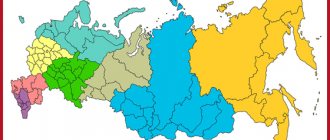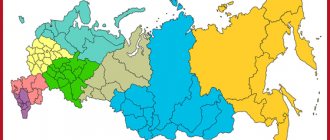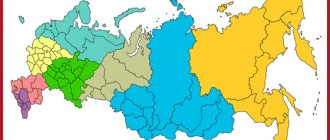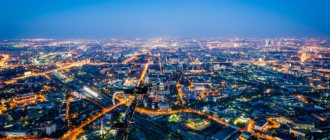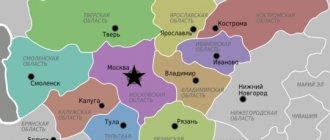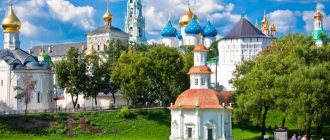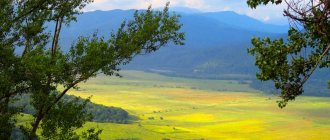Description
General Map
Federal districts of the Russian Federation
Story
May 13, 2000
– Decree of the President of Russia (No. 849). The country was divided into seven federal districts (composition), which are headed by plenipotentiary representatives (plenipotentiary representatives) of the President of Russia - the powers of plenipotentiary representatives operating in the regions of Russia were transferred to them.
June 21, 2000
– Decree of the President of Russia (No. 1149). The North Caucasus Federal District was renamed the Southern Federal District (center - Rostov-on-Don).
January 19, 2010
– Decree of the President of Russia (No. 82). The North Caucasus Federal District (center - Pyatigorsk) was separated from the Southern Federal District - the composition of the new district corresponds to the current one and has not been subject to changes.
March 21, 2014
– Decree of the President of Russia (No. 168). In connection with the admission of Crimea and Sevastopol to Russia, the Crimean Federal District was formed (center - Simferopol).
July 28, 2016
– Decree of the President of Russia (No. 375). The Crimean Federal District was abolished and included in the Southern Federal District.
November 3, 2018
– Decree of the President of Russia (No. 632). Buryatia and the Trans-Baikal Territory were excluded from the Siberian Federal District and included in the Far Eastern Federal District.
December 13, 2018
– Decree of the President of Russia (No. 716). The center of the Far Eastern Federal District was moved from Khabarovsk to Vladivostok.
What else could CFO mean?
In the media, the abbreviation Central Federal District in the vast majority of cases refers to the Central Federal District. Sometimes an option such as TsFORF can be used (the last two letters in this case mean “Russian Federation”).
However, to reduce the CFO, other decoding options are possible. Thus, in accounting documents or management accounting, the CFO will mean “center of financial responsibility”; financiers can abbreviate in this way “stock transaction center,” and in the structures of the Ministry of Internal Affairs the abbreviation is used to designate the departmental “Financial Support Center.”
Composition of federal districts
Central
| Regions of Russia | Map |
1) Belgorod region 2) Bryansk region 3) Vladimir region 4) Voronezh region 5) Ivanovo region 6) Kaluga region 7) Kostroma region Kursk region 9) Lipetsk region 10) Moscow 11) Moscow region 12) Oryol region 13) Ryazan region 14 ) Smolensk region 15) Tambov region 16) Tver region 17) Tula region 18) Yaroslavl region Moscow 11) Moscow region 12) Oryol region 13) Ryazan region 14 ) Smolensk region 15) Tambov region 16) Tver region 17) Tula region 18) Yaroslavl region |
Northwestern
| Regions of Russia | Map |
1) Arkhangelsk region 2) Vologda region 3) Kaliningrad region 4) Karelia 5) Komi 6) Leningrad region 7) Murmansk region Nenets Autonomous Okrug 9) Novgorod region 10) Pskov region 11) St. Petersburg Nenets Autonomous Okrug 9) Novgorod region 10) Pskov region 11) St. Petersburg |
Southern
| Regions of Russia | Map |
1) Adygea 2) Astrakhan region 3) Volgograd region 4) Kalmykia 5) Krasnodar region 6) Republic of Crimea[1] 7) Rostov region Sevastopol[1] Sevastopol[1] |
North Caucasian
| Regions of Russia | Map |
| 1) 20x20px Dagestan 2) Ingushetia 3) Kabardino-Balkaria 4) Karachay-Cherkessia 5) North Ossetia-Alania 6) Stavropol Territory 7) Chechen Republic |
Privolzhsky
| Regions of Russia | Map |
1) Bashkortostan 2) Kirov region 3) Mari El 4) Mordovia 5) Nizhny Novgorod region 6) Orenburg region 7) Penza region Perm region 9) Samara region 10) Saratov region 11) Tatarstan 12) Udmurtia 13) Ulyanovsk region 14) Chuvashia 10) Saratov region 11) Tatarstan 12) Udmurtia 13) Ulyanovsk region 14) Chuvashia |
Ural
| Regions of Russia | Map |
| 1) Kurgan region 2) Sverdlovsk region 3) Tyumen region 4) Khanty-Mansi Autonomous Okrug 5) Chelyabinsk region 6) Yamalo-Nenets Autonomous Okrug |
Siberian
| Regions of Russia | Map |
1) Altai Republic 2) Altai Territory 3) Irkutsk Region 4) Kemerovo Region 5) Krasnoyarsk Territory 6) Novosibirsk Region 7) Omsk Region Tomsk Region 9) Tyva 10) Khakassia Tomsk Region 9) Tyva 10) Khakassia |
Far Eastern
| Regions of Russia | Map |
1) Amur Region 2) Buryatia[2] 3) Jewish Autonomous Okrug 4) Trans-Baikal Territory[2] 5) Kamchatka Territory 6) Magadan Region 7) Primorsky Territory Yakutia 9) Sakhalin Region 10) Khabarovsk Territory 11) Chukotka Autonomous Okrug Yakutia 9) Sakhalin Region 10) Khabarovsk Territory 11) Chukotka Autonomous Okrug |
Northwestern Federal District
The federal districts of Russia include the Northwestern. The authorized representative office of the Northwestern Federal District is located in St. Petersburg. In economic terms, the Northwestern Federal District can be considered one of the most developed in Russia. Both manufacturing and raw materials industries are developed here. The Northwestern Federal District is also characterized by a highly developed transport infrastructure. How many federal districts are there in Russia with a comparable level of road development? It’s difficult to say, since the experience of the Northwestern Federal District in this sense is completely unique.
One of the factors stimulating the growth of the economy of the Northwestern Federal District is its proximity to European countries - Finland, the Baltic countries, Poland (if we talk about the Kaliningrad region). The Northwestern Federal District is characterized by enormous human resources potential. Specialists of various profiles are trained at universities in St. Petersburg and other cities, and all of them receive the highest qualifications. The Northwestern Federal District also contains significant amounts of natural resources.
The structure of the Northwestern Federal District includes the following regions: Arkhangelsk, Vologda, Kaliningrad, Leningrad, Murmansk, Novgorod, Pskov. It is part of the Northwestern Federal District and the republics: Karelia, Komi.
Notes
- ↑ 1,01,1 On July 28, 2016, by decree of the President of Russia (No. 375), they were included in the Southern Federal District.
- ↑ 2,02,1 November 3, 2022, by decree of the President of Russia (No. 632), included in the Far Eastern Federal District
| [ + ] Russia | |
| Armed forces | Army (armed forces modernization) • Armaments • (infantry weapons • military equipment • aviation • armored vehicles • T-14 tank) • Navy • Military districts |
| Symbolism | Coat of Arms of Russia • Flag of Russia • Motto of Russia • Anthem of Russia • Ribbon of St. George • National symbols of Russia |
| Story | Rulers of Russia • The myth of the centuries-old backwardness of Russia • Changes in borders (territorial disputes) • The future of Russia • Reform of the Constitution of Russia (chronology • text of amendments • voting) |
| Economy | Major projects • Industry • Agriculture • Electric power industry • Tourism • Food security • Import substitution • Russian products • Leading companies |
| Finance | Russian ruble • Central Bank (gold reserve • Digital ruble • SPFS • “Mir” • Mir Pay • Fast payment system • NSPK) • Export • Salaries and incomes • Pensions • Standard of living • Taxes • Deoffshorization • Shadowization |
| Transport | Northern Sea Route • Seaports (ocean access) • Airports • SSJ 100 • Transpolar Highway |
| Technologies | Inventions • High-tech products (new developments) • Defense • Aviation industry • Space • Atom (nuclear energy) • Shipbuilding • Automotive industry • Engine building • IT sector (microprocessors • smartphones) • Robotics • Oil industry |
| Medicine | Medicine • Pharmaceuticals • Vaccination |
| Demography | Emigration • Social policy (maternity capital) • Human capital |
| Achievements | Areas of Russia's leadership • Russia ranks first in the world • Russian records • Tsar-things • Russian sports |
| Culture | Music and songs about Russia • Poems about Russia • Poems about war • Quotes about Russia • Russian language (proverbs and sayings) • Russian character • The best modern films about Russia • The future of Russia in science fiction • Achievements of Russian culture ( modern achievements • new churches • restored monuments • lost monuments) • Cultural policy • Putin style |
| Regions and cities | Regions of the Russian Federation (geostrategic regions) • Cities (centers of economic growth • hero cities • cities of military glory • historical settlements) • Federal districts • Economic regions • Macroregions • Russian Arctic • Symbols of regions |
Moscow
Cafes, bars, restaurants
The restaurant business occupies three main niches in the Russian capital: Moscow fast food restaurants, mid-price establishments and elite gourmet restaurants. Recently, places of the St. Petersburg format have become increasingly popular - with beautiful interiors, original cuisine and a price category slightly above average.
White Rabbit Restaurant
Inside the Okhotny Ryad shopping center
Moscow has a huge selection of all kinds of gastronomic establishments, starting with small eateries, full of both original new ones and traditional Moscow ones (“Cheburechnaya”, “Pelmennaya”, “Ryumochnaya”)
names, ending with luxury restaurants. There are cafes, coffee shops and tea houses, small restaurants and restaurants, bars and even pubs that appear and disappear, expand their networks and change locations, as well as those cafes and restaurants whose names and locations have never changed in the history of their existence .
In Moscow you can taste dishes from almost any cuisine in the world. It is important to note that often the menus of restaurants serving national cuisines are composed of dishes from two or more culinary traditions. For example, a Mediterranean restaurant may offer appetizers prepared according to both French and Italian recipes; a Chinese menu may coexist with a Japanese one, and a Japanese menu, in turn, with an Italian one. The menus of most cafes also, as a rule, have their own specifics, determined by the chef’s ideas or the style of the establishment, and do not belong to one and only one gastronomic direction. There are also restaurants in Moscow with exclusive, signature cuisine.
Interior of the restaurant "Planet Sushi"
Chaikhona No. 1 on Pushkinskaya
The new generation of Muscovites perceives sushi and rolls as the most natural food; Japanese restaurants have established themselves as the capital’s most popular eating places - these are the democratic chains “Planet Sushi”, “Yakitoriya”, “Niyama”, “Tanuki”. Next come pizzerias like “IL Patio”, “Dodo Pizza”, “Domino’s Pizza”, and a generation has already grown up for which Bolognese pasta is more familiar than naval pasta and which does not even know that this is, in essence, the same thing. Inexpensive cafes with home-style delicious food can also be found in every district of Moscow - “Mu-mu”, “Karavaev Brothers” and “Moremania” are always full of guests.
Both residents and guests of the capital love to have a good time in Moscow restaurants, and the city always has plenty to choose from. Moscow restaurants differ not only in the quality and variety of food offered, but also in the organization of service: business lunch, buffet and other services.
McDonald's on Manezhnaya Square
In the early 90s, canteens, inexpensive eateries, and children's cafes began to disappear from Moscow. Muscovites and visitors were at a loss. Favorite places changed their signs, and their prices became so high that it was scary to even cross the threshold. And the visitors settled here accordingly. It became unclear where to invite a girl on a date, where to chat with two girlfriends over a cup of coffee, where to treat the baby to dessert. Now in Moscow there are again inexpensive, pleasant coffee shops on every corner - these are, for example, the Coffee House, Shokoladnitsa, Coffee Bean, and Starbucks chains. For fast food lovers, there are also fast food establishments - McDonald's, KFC, Burger King. There are also iconic restaurants serving Russian cuisine - with high prices and a royal atmosphere, for example, Cafe Pushkin.
Just in case, here is a list of traditional Russian dishes:
- jelly (jellied meat)
, boiled pork and balyk; - red, black and eggplant caviar;
- salted mushrooms and sauerkraut;
- salads: vinaigrette, Olivier salad, herring under a fur coat;
- hot borscht with sour cream;
- ear with crayfish necks and pie;
- rich stewed cabbage soup in the cold season;
- okroshka with kvass or kefir in the summer heat;
- dumplings, dumplings and pancakes.
Moscow River in winter
Night life
Moscow at night
Moscow never sleeps: probably everyone knows about the legendary insomnia in Moscow. No one can explore the city in one day or night, but getting a lot of impressions is quite possible. And remember: Moscow during the day and Moscow at night are two completely different cities. First, you can see the sights of the capital. Night Moscow illuminated is an unforgettable sight! Of course, one of the brightest and most beautiful places in Moscow is Red Square and the Kremlin. It's never really dark there. At night, lanterns, bulbs, spotlights, and backlights are constantly on, and fireworks are often displayed. In the light of spotlights, St. Basil's Cathedral acquires some special beauty and becomes even more majestic.
From the observation deck on Sparrow Hills you can enjoy a magnificent view of Moscow glowing with many lights. At night, street racers from all over Moscow gather near Vorobyovy Gory, so you can watch the big race or just admire tuned cars and motorcycles of various models and colors.
Another famous place in the capital is Poklonnaya Hill. In the evening, couples in love arrange romantic dates here. At night, Poklonnaya Gora takes on a different hue – the fountains are illuminated in red.
Moscow at night is famous for its 24-hour cafes and restaurants. Visiting them in the evening is a special pleasure: at night it is not so noisy, no one is in a hurry.
If you don’t want to stroll, but just hang out, then here too Moscow offers a huge selection - “Icon Club”, “Propaganda”, “Chinese pilot Zhao-Da”, “Look in rooms”, “Roof of the World”, “Soho” - nightlife There are a lot of clubs and bars in the capital for every taste.
Night clubs
Accommodation
Luzhniki Bridge
Moscow constantly receives a huge number of guests. Tourism, recreation, exhibitions, business meetings and seminars, training, meetings with relatives - this is just a small list of reasons to come to the capital. More than one and a half million people visit Moscow every day. And approximately four hundred to five hundred thousand guests or tourists cannot come to our capital. The reason is quite prosaic: there is nowhere to live.
Finding a place in a hotel in Moscow, simply by arriving in the city and calling several of the largest hotels, was possible probably only five years ago. After the FIFA World Cup in 2022, the situation with the occupancy of rooms in Moscow constantly resembles the time of some major holiday or exhibition.
So, if you are planning a trip to the Russian capital, you have a rather difficult choice from several options: a business or VIP class room in the city center, a room in one of the three-star hotels in one of the relatively remote areas, a budget room in hotels of a lower level on the outskirts or renting an apartment.
Room in the Landmark Hostel on Arbat
Hotel Cosmos
Objects of the 2-star category are inexpensive hotels in Moscow, their popularity is often due only to the price, since these hotels are located mainly far from the center and the level of service and room equipment leave much to be desired, but there are pleasant exceptions.
Hotel Ukraine (Radisson Royal)
Three-star hotels in Moscow are the main backbone of the capital's inexpensive hotel stock, which is in constant demand among tourists, business travelers, and participants in exhibitions and conferences. To guarantee your reservation, it is strongly recommended to apply 1-2 months in advance. An application for booking a hotel in Moscow does not oblige you to anything; by ordering a room in advance, you can pay for it 2-3 weeks before departure or cancel the reservation. It will cost you much less and without unnecessary nerves and hassle.
The lobby of The St. Regis Moscow Nikolskaya
Most 4-star hotels are distinguished by a wider range of services provided, quality of rooms, service and infrastructure. The contingent of guests of 4-star hotels is diverse: these are domestic and foreign tourists, businessmen, employees of Western and Russian companies, scientists and artists, and athletes. Such Moscow hotels value their reputation, and you will find decent service and a culture of hospitality there. The most popular in this category are the Cosmos and Ukraine hotels in the center of Moscow: they are attractive due to their proximity to the city center, business centers and exhibition grounds, however, like all popular inexpensive accommodation facilities, they are heavily loaded, so we ask you to take care of your room in advance.
View of Tverskaya Street
5-star hotels are among the most expensive hotel complexes. Often these are hotels managed by Western companies, for example, Marriott. Almost all of them are located in the center of the capital and are distinguished by high room rates and a high level of service. If you are counting on a five-star hotel, then there are almost no selection criteria - almost all elite hotels in Moscow offer exactly the level of service that they declare.
Mini-hotels both in Moscow and around the world are distinguished, first of all, by a small number of rooms: from 3 to 50, as well as a smaller range of services; These hotels in Moscow are good for those who prefer a homely, informal atmosphere.
Hotel deals
Booking.com
When to go to Moscow
The ideal time to travel to Moscow is summer. Firstly, everything around is green and beautiful, it’s warm outside. And secondly, Muscovites prefer to relax in the summer and often leave at this time of year. Moscow is not so busy, there are fewer traffic jams, there are also people on the metro, and, accordingly, spending time in the capital without jostling is much more pleasant.
Moscow in winter
Moscow in summer
Moscow in autumn
Transport
Moscow has a well-developed urban transport network. By land transport (the length of the lines is more than 2000 km)
– buses, trolleybuses, trams – more than 5.5 million passengers are transported per day. The daily capacity of the Moscow Metro, the capital's most popular means of transport, is more than 9.5 million people.
Trolleybus
bus
has always been and remains the pride of Muscovites. This is the fastest, most reliable, convenient and inexpensive way to get to any corner of the capital. The capital's metro is famous for its architecture and history. Everyone who comes to Moscow will definitely go down to the “underground palace” dressed in granite and marble to admire the mosaics, sculptures, and stained glass windows.
The bus in Moscow is the most popular and widespread type of transport after the metro. The first buses appeared in the city even before the revolution, and today 18 bus depots serve about a thousand different routes. Modern comfortable cars will deliver not only to any point in the city, but also to the suburbs of the capital.
Today the Moscow trolleybus network is the most extensive in the world. Trolleybus is an economical and environmentally friendly form of transport. In a huge metropolis overloaded with traffic, its advantages are obvious.
Kyiv metro stationKomsomolskaya metro station
Elektrozavodskaya metro station
The tram is the slowest, but also the most environmentally friendly of land transport modes. Few tram routes have survived in the center of Moscow. By choosing a Saturday or Sunday, you can take a wonderful tour of old Moscow, sitting at the window of tram number 39 or the famous “Annushka”.
Moscow traffic jams
It is impossible to imagine life in a big city without a taxi. Meeting and seeing off at train stations and airports, shopping trips, late returns home, trips to an unfamiliar city. Taxi is a part of our life. Currently, about 20,000 taxis officially operate in Moscow.
Another option for getting around Moscow is to drive your own car or rent a car.
In the summer, you can take a leisurely stroll along the Moscow River on the Radisson or River Palace river boat, which, in the absence of time restrictions on certain routes, can act as public transport.
Car rent
The car rental service is well developed in Moscow and is represented by both European and Russian companies. We rent cars of almost any brand and level: an economy class car for daily trips around the city, a luxury car, a minibus, a holiday limousine, a luxurious convertible or a powerful jeep. For long excursions, group trips or meetings of delegations, large buses with air conditioning, toilet and TV are offered.
Kutuzov Avenue
Filling out documents for renting does not take much time - in order to rent a car of any class, you only need a passport and a driver's license.
You can rent a car immediately upon arrival in Moscow - at the airport or train station. If for some reason you had to temporarily be left without your personal car (handed it in for repairs or technical inspection)
, you can immediately find a temporary replacement for it - many car services provide similar services.
Taxi MKAD (Interchange with Novorizhskoe Highway)
In order to get the right car for rent in exactly the configuration that you need, it is best to book it in advance. In Moscow, you can rent a car for any period of time – from several hours to several days or months. Hourly rent will cost more than daily or monthly rent. Companies also rent cars designed for people with disabilities and equipped with all the necessary equipment for disabled people. At the customer's request, any car can be provided with a driver.
After the lease agreement for the selected car is concluded, you will only need to pay for gasoline yourself. All other costs, including insurance, are borne by the company you contacted.
Money
Moscow is one of the most expensive cities in the world, so you need to be mentally and financially prepared to visit it. Calculate the preliminary estimate: the cost of public transport can be more than 100 rubles per day, if you do not live in the center, food in the most inexpensive cafes and eateries in the city will cost at least 500 rubles per day, cultural events - count at the rate of 300-500 rubles per day. visits to one museum (without photography and excursions)
.
Thus, it turns out a minimum of 1000 rubles per day, excluding accommodation. View of the Kremlin
Old Arbat
The national currency of Russia is the ruble. All payments within the country are made in rubles; the presence of the national Russian currency is required when visiting Moscow. A peculiarity of both Moscow and Russia as a whole is the fact that non-cash payments are not often used within the country, and Russians continue to use cash in the vast majority of cases to make current payments, especially small ones. This means that not all retail outlets and catering establishments have the technical ability to accept plastic cards. In this regard, we recommend that you cash out some of your funds in rubles before visiting shops, restaurants or entertainment centers.
In Moscow, you can exchange any cash national currency for rubles. There are many small exchange offices open in the city: in shopping centers, at exits from metro stations, in hotels, shops, cinemas and other public places. The most popular currencies for exchange in Russia are dollars and euros, but in specialized exchange offices and banks they exchange for rubles and any other currency. Exchange rates change daily and are indicated on the information board at the entrance to the exchange office. Most exchange offices are open during the day, but there are also exchange offices that are open 24 hours a day.
Winter morningSberbank
Under no circumstances should you change currency on the street from private individuals, even if they offer to carry out this operation at a favorable rate. Do not use the services of street exchange offices if you want to exchange a large amount of money, especially if the office is suspicious due to its appearance or the behavior of the staff.
The safest place for currency exchange in Moscow is the offices of large Russian and foreign banks, where they provide a full range of banking services. The exchange rate there is sometimes more favorable. Almost every bank has a network of ATMs in Moscow, including 24-hour ones and open on weekends, where you can make any transactions to exchange currency and receive cash. This is the most reliable way to receive cash in rubles.
Red Square
Tips
Lights of Moscow
There are practically no restaurants in Moscow where tips for the waiter are included in the bill. On average, in the capital it is customary to leave 10% of the bill amount (subject to decent service)
, although there is no hard and fast rule.
For a very large order, 5% of the amount will be quite sufficient.
It is considered good form to leave a tip in beauty salons and other establishments that provide personalized service. But in these cases, the size of the tip depends on the client’s wishes.
It is customary to pay taxi drivers a tip, especially since the driver can provide you with a number of services: open the door, load things into the car, help carry them. The amount of remuneration is from 10 to 20%. If you use a private car, you do not need to pay a tip - you have already agreed on the amount when renting the car.
Couriers and messengers can leave change up to 100 rubles. Gas station attendants are usually paid 30-50 rubles.
You have to leave a large amount of tips in hotels (make sure you have small bills)
.
Kosmodamianskaya embankment
Bolshoi Theater
The doorman is supposed to be paid when he helps remove luggage from the car or carries it to the hotel door, or loads things into the car upon departure. Reward amount: 20-50 rub.
A tip to the porter will cost you 50-80 rubles. depending on the number of pieces of luggage.
It is customary to pay the maid from 50 to 100 rubles for each day of stay, depending on the class of the hotel (it is better to leave it on the bed)
.
Novoandreevsky Bridge
You should tip for services such as booking plane tickets or, for example, to the theater. Depending on the service, the amount can range from 150 to 250 rubles.
The size of the tip depends on the level of the hotel. In small hotels, the tip size is naturally smaller.
Privileges
Benefits for transport, museums and sightseeing apply to pensioners, schoolchildren and students. But in order to use them, you must have identification with you, for example, a student ID.
Annual Events
January
Moscow on New Year's Eve
- The night from December 31 to January 1 is New Year.
- January 7 – Christmas.
February
- February 23 is Defender of the Fatherland Day.
- February 14 – Recently, many Moscow establishments have been celebrating Valentine’s Day.
March
- March 8 is International Women's Day.
April
- Easter.
May
May 9 Parade in Moscow
- May 1 – Labor Day.
- May 9 – Victory Day.
June
- June 12 – Russia Day
July
- July 8 is the Day of Family, Love and Fidelity.
September
- The first weekend of September is City Day.
October
- October 31 – Lately, many Moscow establishments have been celebrating Halloween.
November
- November 4 is National Unity Day.
Connection
Where to call in case of emergency:
- 112 – one of the emergency telephone numbers used in the GSM standard, accessible even when the phone keypad is locked or there is no SIM card;
- 101 – Ministry of Emergency Situations and Fire Service;
- 102 – police;
- 103 – emergency medical care;
- 104 – emergency gas service.
Police
International communications
Most hotels will always help you make calls anywhere in the world, send faxes, telegrams and emails. Large hotels usually have rooms with a dedicated Internet connection or Wi-Fi hotspot. However, to make your stay in Moscow easier, you should familiarize yourself in advance with how international and long-distance communications from Moscow are carried out.
Moscow telephone numbers are seven-digit. Moscow telephone code is 495 and 499. Russian telephone code is 007 (+7).
To call abroad from Moscow, dial 8, wait for the dial tone, dial 10, then the country code, city code (without the first 0)
and the number you need.
New Arbat
Moscow River
TTR near the Beijing Hotel
cellular
Honor guard in the Alexander Garden
Tourists coming to Moscow can use their own mobile phones and use the services of their local operators thanks to international roaming. However, if your visit to the Russian capital is planned for a long time, it makes sense to purchase a SIM card from a local operator.
The main cellular operators in the capital are MTS, Beeline, Megafon. The range of services provided varies depending on the coverage area of a particular network, how operators work in the regions, how possible it is to access the mobile Internet with their help, etc. Cellular operators in Moscow provide their customers with all standard services, such as Foreign operators also have them. In particular, intercity and international roaming, various tariffs for suburban areas, mobile payment for operator services and others.
Mobile communications in Moscow allow you to be within the access zone in all areas of the city and even in the metro. In the Moscow metro, the network of the largest operators operates at all stations within the ring, on the Circle Line and at stations of a number of other metro lines. Wi-Fi technology is also available underground.
Each operator has a wide network of offices throughout Moscow; information about services can also be obtained in most stores that sell cell phones. You can also pay for cellular services there. In addition, payment is accepted through instant payment terminals installed on city streets and in retail outlets.
Cathedral of Christ the Savior
Monument to Bulat Okudzhava on Arbat
Internet
Any self-respecting cafe or restaurant has Wi-Fi, so come and use all your gadgets in peace. The wireless access network covers not only public places and Moscow metro stations, but also about a million apartments.
Useful sites
- www.maps.yandex.ru – traffic jams
- www.metro.yandex.ru – metro
- www.2do2go.ru/msk – events
- www.afisha.ru – poster
Timezone
Moscow is in the UTC +3 time zone. Clocks do not change to winter/summer time.
Climate in Moscow
Winter
Winter
Winter in Moscow is long and sometimes harsh. In recent years, snow falls around New Year's, but does not melt until the end of March or even longer. Temperatures range from 0 to –20 degrees on average, but can rise higher or fall lower – it’s unpredictable.
Spring
The trees begin to turn green around May, although the weather becomes warmer somewhat earlier, around April 18th.
Summer
Moscow State University
Temperatures in summer are from +10 to +30 degrees. It is often difficult to live among the stone houses in the heat, and yet this is the most wonderful time of the year in the city. In August it gets colder at night, and you won’t be able to get by with just a T-shirt and shorts.
Autumn
Pleasant weather lasts in Moscow until about the end of September - then the leaves fly away, rains, slush, and gloomy days begin.
How to get there
How to get there by plane
Moscow airports are the largest transport hubs not only nationwide. In terms of the volume of transportation and services provided, the enterprises comply with international standards accepted in these industries.
Using the services of Russian air carriers, you can get to most points in the Russian Federation. Considering the considerable distances of Russia, this is the fastest and most convenient transport for traveling around the country.
Moscow airports have an established transport corridor with almost all capitals of the world. Leading international airlines, such as British Airways, Lufthansa, SAS, Finnair, etc., also offer flights to Moscow. Most foreign tourists use air transport to get to Moscow.
VnukovoDomodedovo
Sheremetyevo
There are three main airports in the Russian capital, all of them are located in close proximity to the city. These are Vnukovo, Domodedovo and Sheremetyevo. The largest number of foreign passenger flights is served by Moscow International Airport Sheremetyevo-2, and domestic flights by Sheremetyevo-1. The airport is well equipped and uses only the highest international standards in its work, including in terms of flight safety.
Domodedovo Airport offers services for international passenger flights. This high-class airport is actively developing and has the most modern technical equipment.
The capital's Vnukovo Airport is located closest to Moscow - it also has international status and receives aircraft from leading domestic and world airlines.
Moscow from above at nightAeroexpress
All Moscow airports operating international flights have an extensive infrastructure: information terminals, a modern passenger check-in system, and comfortable lounges. On the territory there are mother and child rooms, cafes, restaurants, shops, pharmacies, services for the disabled and other services.
Due to the fact that all Moscow airports are located in close proximity to the city limits, travel time from and to the airport takes on average from 30 minutes to 1.5 hours - depending on the time of day, traffic congestion and type of transport.
How to get there by train
Internal and external rail transportation in Russia is carried out by Russian Railways OJSC. Passenger trains depart to 19 countries in Europe and Asia, and in total, currently taking into account new directions (Moscow - Munich, Moscow - Amsterdam, Moscow - Paris and Moscow - Basel)
Trains and direct carriages of Russian Railways run on 56 international routes and are served by both Russian railways and railways of Poland, Germany, France, the Czech Republic, Finland, Mongolia, China, and North Korea.
In total, there are 9 railway stations in Moscow, located in different parts of the city: Belorussky, Kazansky, Kyiv, Kursky, Leningradsky, Paveletsky, Rizhsky, Savelovsky, Yaroslavsky. As a rule, the name of the station corresponds to the direction where trains depart from it. So, from the Belorussky station, trains go to Belarus and further to Western Europe, from Kyiv - to Ukraine and to the countries of Southern Europe. Trains run from Leningradsky Station to St. Petersburg and further to Northern Europe. From Paveletsky (formerly Saratovsky)
station, trains go to the Middle and Lower Volga regions and to neighboring countries, etc. The capital's Savelovsky station provides only suburban service.
Kazan Station
Belorussky StationPaveletsky Station
All Moscow stations, and especially international ones, have a developed infrastructure and well-equipped waiting rooms. On their territory there are cafes, shops, pharmacies and other socially significant objects. All metropolitan stations are equipped with ramps - lifts for the disabled.
Trains departing from Moscow stations can be fast and passenger, long-distance, local and suburban - depending on the speed and distance the train travels. Fast trains make fewer stops along the route than passenger trains, and the duration of these stops is short. There are also branded trains and express trains with luxury carriages. For travel, it is best to choose air-conditioned carriages with four-seater compartments, SV carriages with double compartments, as well as luxury carriages, which have not only air conditioning, but also a TV, Internet access, and a shower room. There are also carriages with special compartments for people with disabilities.
Other modes of transport
Muscovites and guests of the capital can choose water transport and go on a cruise on a motor ship along the rivers of Russia. Comfortable buses depart daily from Moscow bus stations on regional routes.
Calendar of low prices for air tickets
Volga Federal District
Relatively small in area - about 7.27% of the total territory of Russia, the Volga Federal District plays a vital economic and political role in the development of the country. Thus, the share of industry in the economic system of the region is about 23.9%. This is one of the highest indicators among all federal districts of the Russian Federation.
The industry of the Volga Federal District is represented by mechanical engineering, fuel and energy complex, agriculture, chemical and light industry. In the administrative and political structure of the Volga Federal District there are many republics: Udmurt, Chuvash, Bashkortostan, Tatarstan, Mari El, Mordovia. The Volga Federal District has three regions: Kirov, Nizhny Novgorod, and Orenburg.
Actual information
According to official statistics, this figure for the Russian capital in 2022 is 2561.5 sq. km., inside the Moscow Ring Road - 900 sq. km. How much is this in hectares? To answer this question, you need to convert kilometers to hectares. According to the calculation method, 1 sq. km. corresponds to 100 hectares. This means that the area of the first throne in hectares will be 256,150 hectares.
The length of the Russian capital from north to south reaches 38 km within the Moscow Ring Road, and taking into account the territory beyond the Moscow ring road - 51.7.
The population of the city as of 2022 is 12,679,078 people, and in total 17,200,000 people live in the Moscow agglomeration. Moscow ranks first among Russian cities in terms of population. Among European cities it is also a leader in this indicator. Population density - 4880 people per square meter. km. This means that there are 4.88 people per square meter.
